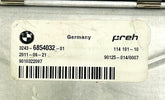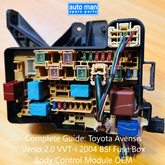A failing car fuse box can cause surprising and dangerous electrical problems. This article shows clear symptoms, safe diagnosis steps, cost expectations, and repair options for U.S. drivers in October 2025.
TL;DR
-
A faulty car fuse box can disrupt multiple electrical systems at once.
-
Watch for intermittent power, repeated blown fuses, burning smells, or no-starts.
-
Safe diagnosis uses a visual check, fuse testing, and a model-specific diagram.
-
Replacement parts typically cost $100–$500; labor and wiring repairs add to the total.
-
Automan Spare Parts offers OEM-style fuse boxes, a 30-day warranty, and worldwide shipping to help source replacements.
What is a car fuse box and how does it work?
The fuse box protects circuits and distributes power to vehicle systems.
A fuse box contains fuses, relays, and wiring hubs that break a circuit when current spikes occur. Fuses are sacrificial devices. Relays switch high-current loads using low-current signals.
Example: A single feed can supply both cabin lights and the radio, so one fault may affect both systems.
How to diagnose fuse box problems safely
Diagnose methodically and prioritize safety to avoid worsening electrical damage.
Start by turning off the ignition and using insulated tools. Locate the correct fuse box and confirm the diagram for your model before testing. Visually inspect for scorch marks, melted wiring, or loose terminals.
Use a multimeter or fused tester to check continuity and correct amperage. Verify each fuse matches the diagram and is the proper rating. Rule out relays and grounding problems, since they can mimic fuse box faults.
Expert tip: If you find melted plastic or a strong burning odor, stop and contact a professional. Fire risk increases with heat.
DIY steps to inspect and replace fuses and when to replace the fuse box
You can replace fuses yourself, but repeated failures often require panel replacement.
Gather the correct fuse box diagram and matching replacement fuses. Power down the vehicle, remove the panel cover, and inspect fuses visually. Replace blown fuses using the same amperage only.
After reassembly, reconnect the battery and test systems. If fuses blow again, search for shorts, damaged wiring, or bad ground points. Replace the fuse box if terminals are corroded, wiring is melted, or the panel heats abnormally.
Fuse box replacement options and costs car fuse box replacement cost
Expect part costs between $100 and $500, with total costs rising for labor or wiring repairs.
The price varies by make, model, and whether you choose OEM-style or aftermarket units. Labor and additional wiring repairs increase the final bill. Most U.S. repairs fall into the $150–$800 range including labor.
Sourcing tip: Choose OEM-style replacements and verify compatibility using a model-specific diagram. Automan Spare Parts stocks tested OEM fuse boxes, provides a 30-day warranty, and offers worldwide shipping for U.S. buyers.
Where is the fuse box located and how to find the right diagram for your car?
Fuse boxes sit under the dash, in the engine bay, or in cargo areas depending on the vehicle.
Check the owner’s manual first for location and diagram pages. Use your vehicle VIN and model details to find a precise diagram online or through a trusted parts supplier. Dealer service manuals and reputable sources like NHTSA provide guidance on wiring and safety recalls.
Real life use case: diagnosing and resolving a faulty fuse box
A short example shows how a simple visual check prevented further damage.
A driver reported intermittent interior lights and radio loss. Visual inspection found a blown fuse and scorched wiring near the fuse box. Replacing the fuse and repairing the damaged wiring restored systems and removed a fire risk.
Lesson learned: Always inspect wiring conditions, not just the fuses. Use correct amperage and consult diagrams before swapping parts.
Prevention and safety tips for fuse box maintenance
Regular checks and correct fuse use reduce risk and prolong electrical system life.
Inspect for corrosion and heat, use the proper fuse amperage, and keep connectors dry. Address small electrical faults early to prevent cascading failures. Maintain a saved copy of your car fuse box diagram for emergencies.
Resources and next steps
Use verified diagrams and trusted suppliers to source parts and decisions.
For compatibility checks and tested OEM parts, consult Automan Spare Parts. Their tested inventory, 30-day warranty, and support options help U.S. drivers find the right fuse box quickly. For safety recall checks, consult AAA or the NHTSA site.
Final Summary
A healthy car fuse box keeps many systems safe and functional. Do a safe visual inspection first, use model diagrams and correct fuse ratings, and replace the panel when you find heat, corrosion, or repeated failures. Explore Automan Spare Parts’ fuse box selection and diagrams to source OEM-style replacements and reduce repair uncertainty.
Browse tested fuse boxes and diagrams at Automan Spare Parts.
FAQ
What are common signs of a bad car fuse box?
Multiple systems failing, repeated fuse blows, burning smells, or heat near the panel.
Can a fuse box be repaired or does it need replacement?
Minor issues like loose terminals can be repaired; melted parts or persistent failures usually need replacement.
How much does a fuse box replacement cost?
Parts typically range $100–$500; labor and wiring add to the total.
How do I know if the problem is a fuse or a relay?
Fuses protect circuits; relays switch high-current devices. Test both with the diagram in hand.
Where can I find the correct fuse box diagram for my car?
Use the owner’s manual, VIN-based online lookups, or verified parts suppliers for model-specific diagrams.
Is it safe to drive with a suspected fuse box problem?
Avoid driving if you smell burning or see melting. For other symptoms, limit use and diagnose quickly.







